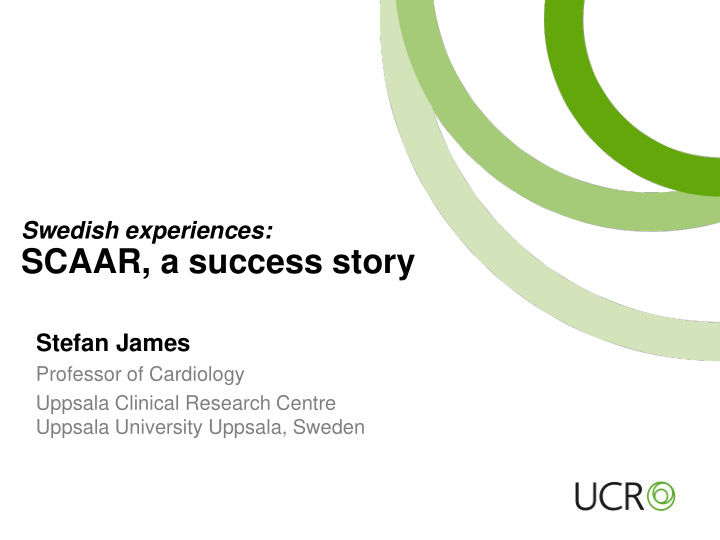



Swedish experiences: SCAAR, a success story Stefan James Professor of Cardiology Uppsala Clinical Research Centre Uppsala University Uppsala, Sweden
Number of cases annually: 80 000 RIKS-HIA 73 CCU hospitals, 100% SCAAR 30 PCI hospitals, 100% Percutaneous valves 7 hospitals, 100% Heart surgery 7 hospitals, 100% Secondary prevention 65 hospitals, 85% Cardiogenetic registry New >300 variables (Baseline data, procedural and outcome measures) At monitoring: 95-96% agreement between files and registry.
Number of cases annually: 80 000 100-200 variables per patient RIKS-HIA 73 CCU hospitals, 100% SCAAR 30 PCI hospitals, 100% • Patients characteristics Percutaneous valves 7 hospitals, 100% • Procedural details (lesions, stents, devices Heart surgery 7 hospitals, 100% Secondary prevention 65 hospitals, 85% etc.) • Pharmacological treatment Cardiogenetic registry New • Complications >300 variables (Baseline data, procedural and outcome measures) At monitoring: 95-96% agreement between files and registry.
SWEDE HEART Name, personal ID number Data entry on line by the operator Automatic linkage with Refered from population registry to provide name, sex Administrative data Date of procedure History is presented and all previously Automated data checks Type of registration Office /call service implanted stents have to be checked Local hospital Clinical background and prior CV disease Auto populated fields from Body length Body length (cm) previous registrations S-creatinine (ug/L Creatinine clearance (ml/min) Calculated variables Prior PCI Prior CABG Diabetes Smoking Angiographic background data
Doctor Doctor Doctor Doctor Doctor Doctor Doctor Doctor
SCAAR Quality indices
Data bases in Sweden based on personal number with patient characteristics, treatments and outcomes 540219-9750 Since 1947 year month day place sex ctrl Biobank Sweden Outpatient Quality health diagnosis Registries Prescription statistics registry since 1995 registry Population EHRs Hospital registry Hospitals and admission primary care registry ICD
Stent Data since 1989 POBA
Patients with stents 2003 DES n= 2 455 10 P=0.11 9 AMI RIKS-HIA % 8 No DES n= 8 434 7 6 ”… these findings are remarkable and may 5 be of great importance but longer follow-up 4 and randomised trials are needed .” 3 2 1 0 0 3 6 9 12 15 18 21 24 Månader
Patients enrolled 2003-2004 and followed max 3 years N=19 771 ?? 0.10 0.08 Cumulative risk of death 0.06 Future potential increased mortality? 0.04 RR: 1.03 (0.84,1.26) 0.02 RR 1.3 (1.1-1.6) RR: 1.32 (1.11,1.57) 0.00 5 y 0.0 0.5 1.0 1.5 2.0 2.5 3.0 Time (years) BMS 12880 12473 12354 12228 9298 5966 3199 N Engl J Med 2007;356:1009-19. DES 5770 5605 5541 5471 3434 1777 626
The SCAAR Scare “ The SCAAR registry is contaminated with flaw data….” M Leon 2007 “ This clearly shows how inappropriate registry studies are….” Kastrati 2007 “ What is rotten in the kingdom of Sweden ” P. Serruys 2008 BMS vs DMS Bare metal stents vs. Death metal stents
Barcelona 2009 SCAAR NEJM 1:st paper BMS DES
Barcelona SCAAR NEJM 2:nd 2009 paper SCAAR NEJM 1:st paper BMS NEW DES Old DES
Patients enrolled 2003-2006 and followed max 5 years N= 47.867 James, N Engl J Med 2009;360(19):1933-45
DES Sirolimus Everolimus Paclitaxel Zotarolimus Biolimus
Adjusted BMS; N=64631 o-DES; N=19202 n-DES; N= 10551
Orsiro Xience Promus premier Synergy Ultimaster Onyx
All stents implanted 2005- September 2016 N= 304 367 Crude rates Old DES 2.9% BMS 1.7% New DES 0.7%
Register based Randomized Clinical trials- R-RCT Prosective randomized trial that uses a clinical registry for one or several major functions for trial conduct and outcomes reporting.
Randomize and store data Did the patient consent? Are inclusion and exclusion crieteria met?
TASTE inclusion rate Patients All primary PCI:s Eligible Randomized 7244 patients Date
The simplest and most pragmatic design HR 1 year 0.94 (0.78 – 1.15), P=0.57 HR up to 30 days 0.94 (0.72 - 1.22), P=0.63
Guidelines Title Citation Class LOE 2012 ESC Guidelines ST- European Heart Journal Routine aspiration should IIa B segment elevation myocardial 2012 Oct;33(20):2569-619 be considered infarction . 2014 ESC/EACTS guidelines on Eur Heart J. 2014 Oct May be considered in IIb A myocardial revascularization 1;35(37):2541-619 selected patients 2015 ACC/AHA focused update JACC Routine thrombectomy III A PPCI not useful 2015 ACC/AHA focused update JACC Selective and bailout IIb C PPCI Thrombectomy not well established 2017 ESC Guidelines ST- European Heart Journal Routine use of thrombus III A segment elevation myocardial 2017 aspiration is not infarction recommended.
SWEDE HEART Thrombus aspiration post Taste Mean use during trial Mean use immediately after trial
*Inclusion criteria: • symptoms suggestive of AMI within 6h • SpO2 ≥ 90% • ≥ 30y • ECG changes indicating ischemia and/or elevated troponin levels R 1:1 Primary Endpoint: 1-year total mortality Additional secondary endpoint and sub studies Data analysis through SWEDEHEART registry and national mortality registry Funding: Swedish Research council (VR)
Primary Endpoint up to 365 days Oxygen treatment Ambient air 5.1 % Ambient air Oxygen treatment 5.0 % HR 0.97 95% CI, 0.79 – 1.21 P=0.8
VALIDATE (R-RCT) STEMI (n=3000) or NSTEMI (n=3000) Pre-treatment with Ticagrelor, Prasugrel or Cangrelor Angiography: PCI intended R 1:1 Bivalirudin Heparin only (5000U Heparin pre-hospital (70-100U/kg) or 3000U pre-PCI) Primary Endpoint: NACE: Death, Myocardial Infarction or Bleeding complication (BARC 2, 3 or 5) at 6 months FU: Register data, combined with phone call endpoint follow up and CEC Funding: Heart-lung foundation. Swedish research council, Astra Zeneca, The Medicines company.
Primary Endpoint at 180 days HR 0.96 95% CI, 0.83 – 1.10 P=0.54
Primary PCI of STEMI/rescue- Total n=4052 patients PCI/risk evaluation following 2026 patients in each arm thrombolysis/very high risk Exclude: NSTEMI Previous CABG Left main disease > 1 non-culprit lesions Cardiogenic chock Visual estimation non-culprit vessel at least 2.5 mm on angiography (50-99%) amenable for PCI 1:1 Within 6 h from puncture time Randomization of index procedure Initial conservative FFR-guided PCI management of non-culprit of non-culprit lesions Eligible but not randomized lesions during index admission* Trial follow-up for endpoints at 30 days and at least 1 year Registry follow-up *Admission meaning initial PCI-capable unit or after transfer to another PCI-capable unit
Recommend
More recommend